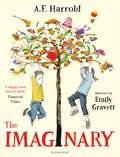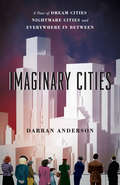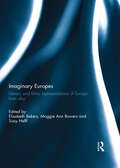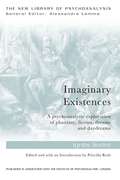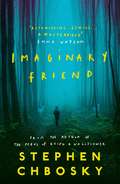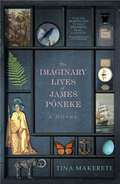- Table View
- List View
Images of the American City
by Anselm L. StraussOriginally published in 1961, Images of the American City examines how Americans dealt with the rapid shock of urbanization as it evolved from an agricultural nation. Working from the framework of a social psychologist, Anselm L. Strauss offers a deeper look into the sociological, psychological, and historical perspectives of urban development. He describes how the cultural changes of a space ultimately develop urban imagery by looking towards the urbanization of America from peoples' views of the cities rather than how the cities are themselves. Urban imageries are contrasted with the context of an ideal city and visitors' perspectives of cities. Strauss takes a step back to ask questions about what Americans think and have thought of their cities. How do these cities compare to the image of an ideal city? What are the different perspectives between a city-dweller and a visitor? He contrasts the tension between those within the city and those outside of its urban limits. Strauss describes how space and time are major themes in the symbolic urbanization of a city. He offers a macroscopic view of the city as a whole and shows how urban imageries evolved from changes in lifestyles. He then provides historical breakdowns of different regions of the country and how they were urbanized. This book documents and illustrates the change in American symbolization from the growth of American cities to the union of urbanity and rurality.
Images of the American City
by Anselm L. StraussOriginally published in 1961, Images of the American City examines how Americans dealt with the rapid shock of urbanization as it evolved from an agricultural nation. Working from the framework of a social psychologist, Anselm L. Strauss offers a deeper look into the sociological, psychological, and historical perspectives of urban development. He describes how the cultural changes of a space ultimately develop urban imagery by looking towards the urbanization of America from peoples' views of the cities rather than how the cities are themselves. Urban imageries are contrasted with the context of an ideal city and visitors' perspectives of cities. Strauss takes a step back to ask questions about what Americans think and have thought of their cities. How do these cities compare to the image of an ideal city? What are the different perspectives between a city-dweller and a visitor? He contrasts the tension between those within the city and those outside of its urban limits. Strauss describes how space and time are major themes in the symbolic urbanization of a city. He offers a macroscopic view of the city as a whole and shows how urban imageries evolved from changes in lifestyles. He then provides historical breakdowns of different regions of the country and how they were urbanized. This book documents and illustrates the change in American symbolization from the growth of American cities to the union of urbanity and rurality.
The Imaginary
by Emily Gravett A. F. HarroldRudger is Amanda Shuffleup's imaginary friend. Nobody else can see Rudger--until the evil Mr. Bunting arrives at Amanda's door. Mr. Bunting hunts imaginaries. Rumor has it that he even eats them. And now he's found Rudger.Soon Rudger is alone, and running for his imaginary life. He needs to find Amanda before Mr. Bunting catches him--and before Amanda forgets him and he fades away to nothing. But how can an unreal boy stand alone in the real world?In the vein of Coraline, this gripping take on imaginary friends comes to life in a lush package: beautiful illustrations (10 in full color) by acclaimed artist Emily Gravett, a foiled and debossed case cover, printed endpapers, and deckled page edges.
The Imaginary
by A. F. Harrold Emily GravettRudger is Amanda's best friend. He doesn't exist, but nobody's perfect. Only Amanda can see her imaginary friend – until the sinister Mr Bunting arrives at Amanda's door. Mr Bunting hunts imaginaries. Rumour says that he eats them. And he's sniffed out Rudger. Soon Rudger is alone, and running for his imaginary life. But can a boy who isn't there survive without a friend to dream him up? A brilliantly funny, scary and moving read from the unique imagination of A.F. Harrold, this beautiful book is astoundingly illustrated with integrated art and colour spreads by the award-winning Emily Gravett.
Imaginary Cities: A Tour of Dream Cities, Nightmare Cities, and Everywhere in Between
by Darran AndersonFor as long as humans have gathered in cities, those cities have had their shining—or shadowy—counterparts. Imaginary cities, potential cities, future cities, perfect cities. It is as if the city itself, its inescapable gritty reality and elbow-to-elbow nature, demands we call into being some alternative, yearned-for better place. This book is about those cities. It’s neither a history of grand plans nor a literary exploration of the utopian impulse, but rather something different, hybrid, idiosyncratic. It’s a magpie’s book, full of characters and incidents and ideas drawn from cities real and imagined around the globe and throughout history. Thomas More’s allegorical island shares space with Soviet mega-planning; Marco Polo links up with James Joyce’s meticulously imagined Dublin; the medieval land of Cockaigne meets the hopeful future of Star Trek. With Darran Anderson as our guide, we find common themes and recurring dreams, tied to the seemingly ineluctable problems of our actual cities, of poverty and exclusion and waste and destruction. And that’s where Imaginary Cities becomes more than a mere—if ecstatically entertaining—intellectual exercise: for, as Anderson says, “If a city can be imagined into being, it can be re-imagined.” Every architect, philosopher, artist, writer, planner, or citizen who dreams up an imaginary city offers lessons for our real ones; harnessing those flights of hopeful fancy can help us improve the streets where we live. Though it shares DNA with books as disparate as Calvino’s Invisible Cities and Jane Jacobs’s Death and Life of Great American Cities, there’s no other book quite like Imaginary Cities. After reading it, you’ll walk the streets of your city—real or imagined—with fresh eyes.
Imaginary Cities: A Tour of Dream Cities, Nightmare Cities, and Everywhere in Between
by Darran AndersonFor as long as humans have gathered in cities, those cities have had their shining—or shadowy—counterparts. Imaginary cities, potential cities, future cities, perfect cities. It is as if the city itself, its inescapable gritty reality and elbow-to-elbow nature, demands we call into being some alternative, yearned-for better place. This book is about those cities. It’s neither a history of grand plans nor a literary exploration of the utopian impulse, but rather something different, hybrid, idiosyncratic. It’s a magpie’s book, full of characters and incidents and ideas drawn from cities real and imagined around the globe and throughout history. Thomas More’s allegorical island shares space with Soviet mega-planning; Marco Polo links up with James Joyce’s meticulously imagined Dublin; the medieval land of Cockaigne meets the hopeful future of Star Trek. With Darran Anderson as our guide, we find common themes and recurring dreams, tied to the seemingly ineluctable problems of our actual cities, of poverty and exclusion and waste and destruction. And that’s where Imaginary Cities becomes more than a mere—if ecstatically entertaining—intellectual exercise: for, as Anderson says, “If a city can be imagined into being, it can be re-imagined.” Every architect, philosopher, artist, writer, planner, or citizen who dreams up an imaginary city offers lessons for our real ones; harnessing those flights of hopeful fancy can help us improve the streets where we live. Though it shares DNA with books as disparate as Calvino’s Invisible Cities and Jane Jacobs’s Death and Life of Great American Cities, there’s no other book quite like Imaginary Cities. After reading it, you’ll walk the streets of your city—real or imagined—with fresh eyes.
Imaginary Cities: A Tour of Dream Cities, Nightmare Cities, and Everywhere in Between
by Darran AndersonFor as long as humans have gathered in cities, those cities have had their shining—or shadowy—counterparts. Imaginary cities, potential cities, future cities, perfect cities. It is as if the city itself, its inescapable gritty reality and elbow-to-elbow nature, demands we call into being some alternative, yearned-for better place. This book is about those cities. It’s neither a history of grand plans nor a literary exploration of the utopian impulse, but rather something different, hybrid, idiosyncratic. It’s a magpie’s book, full of characters and incidents and ideas drawn from cities real and imagined around the globe and throughout history. Thomas More’s allegorical island shares space with Soviet mega-planning; Marco Polo links up with James Joyce’s meticulously imagined Dublin; the medieval land of Cockaigne meets the hopeful future of Star Trek. With Darran Anderson as our guide, we find common themes and recurring dreams, tied to the seemingly ineluctable problems of our actual cities, of poverty and exclusion and waste and destruction. And that’s where Imaginary Cities becomes more than a mere—if ecstatically entertaining—intellectual exercise: for, as Anderson says, “If a city can be imagined into being, it can be re-imagined.” Every architect, philosopher, artist, writer, planner, or citizen who dreams up an imaginary city offers lessons for our real ones; harnessing those flights of hopeful fancy can help us improve the streets where we live. Though it shares DNA with books as disparate as Calvino’s Invisible Cities and Jane Jacobs’s Death and Life of Great American Cities, there’s no other book quite like Imaginary Cities. After reading it, you’ll walk the streets of your city—real or imagined—with fresh eyes.
Imaginary Cities: A Tour of Dream Cities, Nightmare Cities, and Everywhere in Between
by Darran AndersonFor as long as humans have gathered in cities, those cities have had their shining—or shadowy—counterparts. Imaginary cities, potential cities, future cities, perfect cities. It is as if the city itself, its inescapable gritty reality and elbow-to-elbow nature, demands we call into being some alternative, yearned-for better place. This book is about those cities. It’s neither a history of grand plans nor a literary exploration of the utopian impulse, but rather something different, hybrid, idiosyncratic. It’s a magpie’s book, full of characters and incidents and ideas drawn from cities real and imagined around the globe and throughout history. Thomas More’s allegorical island shares space with Soviet mega-planning; Marco Polo links up with James Joyce’s meticulously imagined Dublin; the medieval land of Cockaigne meets the hopeful future of Star Trek. With Darran Anderson as our guide, we find common themes and recurring dreams, tied to the seemingly ineluctable problems of our actual cities, of poverty and exclusion and waste and destruction. And that’s where Imaginary Cities becomes more than a mere—if ecstatically entertaining—intellectual exercise: for, as Anderson says, “If a city can be imagined into being, it can be re-imagined.” Every architect, philosopher, artist, writer, planner, or citizen who dreams up an imaginary city offers lessons for our real ones; harnessing those flights of hopeful fancy can help us improve the streets where we live. Though it shares DNA with books as disparate as Calvino’s Invisible Cities and Jane Jacobs’s Death and Life of Great American Cities, there’s no other book quite like Imaginary Cities. After reading it, you’ll walk the streets of your city—real or imagined—with fresh eyes.
Imaginary Citizens: Child Readers and the Limits of American Independence, 1640–1868
by Courtney Weikle-MillsFrom the colonial period to the end of the Civil War, children’s books taught young Americans how to be good citizens and gave them the freedom, autonomy, and possibility to imagine themselves as such, despite the actual limitations of the law concerning child citizenship. Imaginary Citizens argues that the origin and evolution of the concept of citizenship in the United States centrally involved struggles over the meaning and boundaries of childhood. Children were thought of as more than witnesses to American history and governance—they were representatives of "the people" in general. Early on, the parent-child relationship was used as an analogy for the relationship between England and America, and later, the president was equated to a father and the people to his children. There was a backlash, however. In order to contest the patriarchal idea that all individuals owed childlike submission to their rulers, Americans looked to new theories of human development that limited political responsibility to those with a mature ability to reason. Yet Americans also based their concept of citizenship on the idea that all people are free and accountable at every age. Courtney Weikle-Mills discusses such characters as Goody Two-Shoes, Ichabod Crane, and Tom Sawyer in terms of how they reflect these conflicting ideals.
Imaginary Citizens: Child Readers and the Limits of American Independence, 1640–1868
by Courtney Weikle-MillsFrom the colonial period to the end of the Civil War, children’s books taught young Americans how to be good citizens and gave them the freedom, autonomy, and possibility to imagine themselves as such, despite the actual limitations of the law concerning child citizenship. Imaginary Citizens argues that the origin and evolution of the concept of citizenship in the United States centrally involved struggles over the meaning and boundaries of childhood. Children were thought of as more than witnesses to American history and governance—they were representatives of "the people" in general. Early on, the parent-child relationship was used as an analogy for the relationship between England and America, and later, the president was equated to a father and the people to his children. There was a backlash, however. In order to contest the patriarchal idea that all individuals owed childlike submission to their rulers, Americans looked to new theories of human development that limited political responsibility to those with a mature ability to reason. Yet Americans also based their concept of citizenship on the idea that all people are free and accountable at every age. Courtney Weikle-Mills discusses such characters as Goody Two-Shoes, Ichabod Crane, and Tom Sawyer in terms of how they reflect these conflicting ideals.
An Imaginary England: Nation, Landscape and Literature, 1840–1920
by Roger EbbatsonIn his highly theorised and original book, Roger Ebbatson traces the emergence of conceptions of England and Englishness from 1840 to 1920. His study concentrates on poetry and fiction by authors such as Alfred Lord Tennyson, Richard Jefferies, Thomas Hardy, Q, Rupert Brooke and D.H. Lawrence, reading them as a body of work through which a series of problematic English identities are imaginatively constructed. Of particular concern is the way literary landscapes serve as signs not only of identity but also of difference. Ebbatson demonstrates how a sense of cultural rootedness is contested during the period by the experiences of those on the societal margins, whether sexual, national, social or racial, resulting in a feeling of homelessness even in the most self-consciously 'English' texts. In the face of gradual imperial and industrial decline, Ebbatson argues, foreign and colonial cultures played a crucial role in transforming Englishness from a stable body of values and experiences into a much more ambiguous concept in continuous conflict with factors on the geographical or psychological 'periphery'.
An Imaginary England: Nation, Landscape and Literature, 1840–1920
by Roger EbbatsonIn his highly theorised and original book, Roger Ebbatson traces the emergence of conceptions of England and Englishness from 1840 to 1920. His study concentrates on poetry and fiction by authors such as Alfred Lord Tennyson, Richard Jefferies, Thomas Hardy, Q, Rupert Brooke and D.H. Lawrence, reading them as a body of work through which a series of problematic English identities are imaginatively constructed. Of particular concern is the way literary landscapes serve as signs not only of identity but also of difference. Ebbatson demonstrates how a sense of cultural rootedness is contested during the period by the experiences of those on the societal margins, whether sexual, national, social or racial, resulting in a feeling of homelessness even in the most self-consciously 'English' texts. In the face of gradual imperial and industrial decline, Ebbatson argues, foreign and colonial cultures played a crucial role in transforming Englishness from a stable body of values and experiences into a much more ambiguous concept in continuous conflict with factors on the geographical or psychological 'periphery'.
Imaginary Europes: Literary and filmic representations of Europe from afar
by Elisabeth Bekers Maggie Ann Bowers Sissy HelffThe 20th century has witnessed crucial changes in our perceptions of Europe. Two World Wars and many regional conflicts, the end of empires and of the Eastern Bloc, the creation and expansion of the European Union, and the continuous reshaping of Europe’s population through emigration, immigration, and globalization have led to a proliferation of images of Europe within the continent and beyond. While Eurocentrism governs current public debates in Europe, this book takes a special interest in literary and cinematographic imaginings of Europe that are produced from more distant, decentred, or peripheral vantage points and across differences of political power, ideological or ethnic affinity, cultural currency, linguistic practice, and geographical location. The contributions to this book demonstrate how these particular imaginings of Europe, often without first-hand experience of the continent, do not simply hold up a mirror to Europe, but dare to conceive of new perspectives and constellations for Europe that call for a shifting of critical positions. In so doing, the artistic visions from afar confirm the significance of cultural imagination in (re)conceptualizing the past, present, and future of Europe. This book was originally published as a special issue of the Journal of Postcolonial Writing.
Imaginary Europes: Literary and filmic representations of Europe from afar
by Elisabeth Bekers, Maggie Ann Bowers and Sissy HelffThe 20th century has witnessed crucial changes in our perceptions of Europe. Two World Wars and many regional conflicts, the end of empires and of the Eastern Bloc, the creation and expansion of the European Union, and the continuous reshaping of Europe’s population through emigration, immigration, and globalization have led to a proliferation of images of Europe within the continent and beyond. While Eurocentrism governs current public debates in Europe, this book takes a special interest in literary and cinematographic imaginings of Europe that are produced from more distant, decentred, or peripheral vantage points and across differences of political power, ideological or ethnic affinity, cultural currency, linguistic practice, and geographical location. The contributions to this book demonstrate how these particular imaginings of Europe, often without first-hand experience of the continent, do not simply hold up a mirror to Europe, but dare to conceive of new perspectives and constellations for Europe that call for a shifting of critical positions. In so doing, the artistic visions from afar confirm the significance of cultural imagination in (re)conceptualizing the past, present, and future of Europe. This book was originally published as a special issue of the Journal of Postcolonial Writing.
Imaginary Existences: A psychoanalytic exploration of phantasy, fiction, dreams and daydreams (The New Library of Psychoanalysis)
by Ignes SodreImaginary Existences: A psychoanalytic exploration of phantasy, fiction, dreams and daydreams interweaves scholarly psychoanalytic knowledge and extensive clinical experience with insights derived from close readings of great literature in a uniquely imaginative and creative manner, convincingly demonstrating how these two ways of thinking – psychoanalysis and literary criticism – organically relate to each other. This is simultaneously a psychoanalytic book and a book about literature, illuminating the imaginative possibilities present within both the psychoanalytic encounter and the act of reading fiction. Scholarly and well researched, the psychoanalytic ideas presented have their basis in the work of Freud and Klein and some of their followers; the extensive and innovative writing about the great authors in Western literature is equally scholarly and lucent. Here, Ignês Sodré explores creativity itself and, specifically, the impediments to creative thinking: defences, mostly narcissistic, against dependency, guilt and loss, and the mis-use of imagination to deny reality. In her studies of the characters created by authors such as George Eliot, Cervantes, Flaubert, Thomas Mann, Proust and Shakespeare, Sodré examines the way great writers create characters who mis-use their imagination, twisting reality into romantic daydreams or sado-masochistic enactments, which petrify experience and freeze the fluidity of thought. Her clinical studies continue and expand this theme, broadening the field and lending verification and weight to the arguments. These two poles of Sodré’s thinking – psychoanalysis and literature – interact seamlessly in Imaginary Existences; the two disciplines work together, each an intimate part of a learned exploration of the human condition: our desires, our fears and our delusions. This convergence pays tribute to the great depth of the fictional work being studied and to the psychological validity of the psychoanalytic ideas. This book will be of interest to psychoanalysts, psychologists, psychotherapists, literary critics, and those interested in literature and literary criticism.
Imaginary Existences: A psychoanalytic exploration of phantasy, fiction, dreams and daydreams (The New Library of Psychoanalysis)
by Ignes SodreImaginary Existences: A psychoanalytic exploration of phantasy, fiction, dreams and daydreams interweaves scholarly psychoanalytic knowledge and extensive clinical experience with insights derived from close readings of great literature in a uniquely imaginative and creative manner, convincingly demonstrating how these two ways of thinking – psychoanalysis and literary criticism – organically relate to each other. This is simultaneously a psychoanalytic book and a book about literature, illuminating the imaginative possibilities present within both the psychoanalytic encounter and the act of reading fiction. Scholarly and well researched, the psychoanalytic ideas presented have their basis in the work of Freud and Klein and some of their followers; the extensive and innovative writing about the great authors in Western literature is equally scholarly and lucent. Here, Ignês Sodré explores creativity itself and, specifically, the impediments to creative thinking: defences, mostly narcissistic, against dependency, guilt and loss, and the mis-use of imagination to deny reality. In her studies of the characters created by authors such as George Eliot, Cervantes, Flaubert, Thomas Mann, Proust and Shakespeare, Sodré examines the way great writers create characters who mis-use their imagination, twisting reality into romantic daydreams or sado-masochistic enactments, which petrify experience and freeze the fluidity of thought. Her clinical studies continue and expand this theme, broadening the field and lending verification and weight to the arguments. These two poles of Sodré’s thinking – psychoanalysis and literature – interact seamlessly in Imaginary Existences; the two disciplines work together, each an intimate part of a learned exploration of the human condition: our desires, our fears and our delusions. This convergence pays tribute to the great depth of the fictional work being studied and to the psychological validity of the psychoanalytic ideas. This book will be of interest to psychoanalysts, psychologists, psychotherapists, literary critics, and those interested in literature and literary criticism.
Imaginary Friend: The new novel from the author of The Perks Of Being a Wallflower
by Stephen ChboskyIMAGINE...Leaving your house in the middle of the night. Knowing your mother is doing her best, but she's just as scared as you.IMAGINE...Starting a new school, making friends.Seeing how happy it makes your mother.Hearing a voice, calling out to you.IMAGINE...Following the signs, into the woods.Going missing for six days.Remembering nothing about what happened.IMAGINE...Something that will change everything...And having to save everyone you love.
The Imaginary Library: An Essay on Literature and Society
by Alvin B. KernanIn this speculative treatment of literature as a social institution, Alvin B. Kernan explores the inability of contemporary writers and critics to maintain a literary vision in a society that denies their values and methods.Originally published in 1982.The Princeton Legacy Library uses the latest print-on-demand technology to again make available previously out-of-print books from the distinguished backlist of Princeton University Press. These editions preserve the original texts of these important books while presenting them in durable paperback and hardcover editions. The goal of the Princeton Legacy Library is to vastly increase access to the rich scholarly heritage found in the thousands of books published by Princeton University Press since its founding in 1905.
An Imaginary Life (Vintage International Series #Vol. 11)
by David MaloufIn the first century AD, Publius Ovidius Naso, the most urbane and irreverant poet of imperial Rome, was banished to a remote village on the edge of the Black Sea. From these sparse facts, one of our most distinguished novelists has fashioned an audacious and supremely moving work of fiction. Marooned on the edge of the known world, exiled from his native tongue, Ovid depends on the kindness of barbarians who impate their dead and converse with the spirit world. But then he becomes the guardian of a still more savage creature, a feral child who has grown up among deer. What ensues is a luminous encounter between civilization and nature, as enacted by a poet who once catalogued the treacheries of love and a boy who slowly learns how to give it.
The Imaginary Lives of James Poneke
by Tina MakeretiJames Pōneke is a young Māori orphan, raised by missionaries, with a burning desire to travel and explore the world. When an English artist on a tour of New Zealand invites James to return home with him, the boy eagerly accepts and agrees to become a living exhibit at the artist’s London show.Gainsborough loathes pandering to grand sitters, but he changes his tune when he is commissioned to paint King George III and his large family. In their final, most bitter competition, who will be chosen as court painter, Tom or Sir Joshua?By day, James dresses in full tribal outfit, being stared at, prodded and examined by paying visitors. By night, he is free to explore the city, but anything can happen to a young New Zealander on the savage streets of Victorian London and James is unprepared for the wonders, dangers and unearthed secrets that await.The Imaginary Lives of James Pōneke is an unforgettable work of historical fiction in the spirit of Sarah Waters and Sarah Perry.'A historical love letter to London, a coming-of-age story, a love story’ – Stella Duffy‘A riveting vision of the world seen from the inside out. The Imaginary Lives of James Pōneke is a gutsy, searing and totally absorbing read. I loved it all the way’ – Fiona Kidman‘Made streets I’ve walked a thousand times seem new and strange’ – Damian Barr
Imaginary Maps
by Mahasweta DeviImaginary Maps presents three stories from noted Bengali writer Mahasweta Devi in conjunction with readings of these tales by famed cultural and literary critic, Gayatri Chakravorty Spivak. Weaving history, myth and current political realities, these stories explore troubling motifs in contemporary Indian life through the figures and narratives of indigenous tribes in India. At once delicate and violent, Devi's stories map the experiences of the "tribals" and tribal life under decolonization. In "The Hunt," "Douloti the Bountiful" and the deftly wrought allegory of tribal agony "Pterodactyl, Pirtha, and Puran Sahay," Ms. Devi links the specific fate of tribals in India to that of marginalized peoples everywhere. Gayatri Spivak's readings of these stories connect the necessary "power lines" within them, not only between local and international structures of power (patriarchy, nationalisms, late capitalism), but also to the university.
Imaginary Maps
by Mahasweta DeviImaginary Maps presents three stories from noted Bengali writer Mahasweta Devi in conjunction with readings of these tales by famed cultural and literary critic, Gayatri Chakravorty Spivak. Weaving history, myth and current political realities, these stories explore troubling motifs in contemporary Indian life through the figures and narratives of indigenous tribes in India. At once delicate and violent, Devi's stories map the experiences of the "tribals" and tribal life under decolonization. In "The Hunt," "Douloti the Bountiful" and the deftly wrought allegory of tribal agony "Pterodactyl, Pirtha, and Puran Sahay," Ms. Devi links the specific fate of tribals in India to that of marginalized peoples everywhere. Gayatri Spivak's readings of these stories connect the necessary "power lines" within them, not only between local and international structures of power (patriarchy, nationalisms, late capitalism), but also to the university.
Imaginary Toys
by Julian MitchellImaginary Toys (1961) marked the literary debut of the then 26-year-old Julian Mitchell, who would eventually set aside his prizewinning career as a novelist and achieve wider renown as a dramatist, most famously with Another Country (1981). Imaginary Toys is a novel of Oxford after World War Two, where class consciousness has become newly acute, and a quartet of narrators wrestle with their studies and their more personal difficulties - among the four a coalminer's son and the daughter of a solid bourgeois family, who fall in love to the discomfort of their respective friends.In the first of a sequence of reflective, autobiographical new introductions composed especially for Faber Finds' reissues of his early novels, Julian Mitchell recalls the atmosphere of mid-1950s Oxford, and the path he took to a literary vocation.
Imaginary Worlds: Invitation to an Argument (Palgrave Studies in Literary Anthropology)
by Wayne FifeIn this work, the author contends that we should create a comparative framework for the study of imaginary worlds in the social sciences. Making use of extended examples from both science fiction and fantasy fiction, as well as the living movement of steampunk, the reader is invited to an argument about how best to define imaginary worlds and approach them as social locations for qualitative research. It is suggested in this volume that increasing economic and existential forms of alienation fuel the contemporary surge of participation in imaginary worlds (from gaming worlds to young adult novels) and impel a search for more humane forms of social and cultural organization. Suggestions are made about the usefulness of imaginary worlds to social scientists as places for both testing out theoretical formulations and as tools for teaching in our classrooms.


